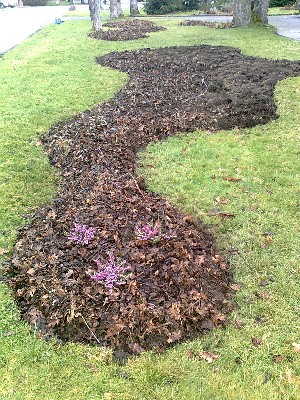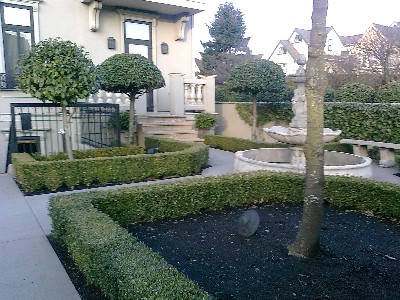Winter Activity
 With the temperature warming back up above zero, work can recommence!
With the temperature warming back up above zero, work can recommence!
Although working sodden soil will ruin the soil structure, tilling the soil is not always necessary. Wet lawns can be overturned then heavily mulched. This opens up an opportunity to develop new garden beds you may have been thinking about. I can help you do this, and here is the process I would suggest:
1) Make a plan.
- Sketch out the new beds in the lawn using twine or rope, or by actually making a line in the lawn with a shovel to decide what that new bed shape will be. The vogue these days is for wavy lines rather than straight edges, unless you are putting in a very formal garden (see photo),
 because a wavy edge is more interesting to the eye, and piques curiosity about what is around the next bend. Keep in mind that smaller curves are more challenging to mow and edge around. While doing this, imagine how people like to travel in the yard so that there are either paths or lawns for them to walk on.
because a wavy edge is more interesting to the eye, and piques curiosity about what is around the next bend. Keep in mind that smaller curves are more challenging to mow and edge around. While doing this, imagine how people like to travel in the yard so that there are either paths or lawns for them to walk on.
- You may have an idea about the plants you wish to grow, and need to plan sufficient space for each plant as it matures. Giving the plants enough space to grow to their natural size and shape will cut down on transplanting and pruning. It also gives the garden a relaxed feel and maybe more habitat for birds.
- You can also create "garden rooms" for outdoor living with your plants. For instance, you may want a quiet sitting area apart from an actively used lawn or a dining patio. You may also want to screen your view of utility areas or a busy road.
- Your plantings can frame a view or create a focal point around a special plant.
- One of the great benefits to having a garden is the ability to create privacy around your home. When doing this it is important to maintain a degree of visibility with your neighbours, especially around your doors and windows. Dense bushes close to doors and windows inadvertently provide cover for thieves trying to break into your house. With some visibility, it is more likely that someone will see the the criminals and call the police.
2) Get to work!
- Next, the exciting and energetic part, turning over the lawn! Doing this may reveal some surprises, like a very wet part of the lawn/garden that will please a moisture-loving plant, or some shallowly buried pipes. Experience tells that digging somewhat tentatively and making note of where the known sprinkler pipes are can save a hassle.
- The top layer of soil just under the sod is rich in organic matter and nutrients, so letting the sod decompose upside down, or in the compost preserves these important aspects of the soil.
3) Cover bare soil.
- After overturning the sod, heavily mulching the new beds with organic mulch can virtually eliminate weeding and tilling in the future. The mulch smothers any grass that may try to regrow and smothers any weed seeds that would like to germinate on the newly exposed soil. The mulch also starts to decompose, turning into compost at the soil interface. Earthworms feed on the decaying overturned lawn and mulch, aerating and fertilizing the soil by moving through it. The mulch at the surface protects the soil from drying out in the wind and sun and compacting in the heavy rain.
- Your own compost in any stage of decomposition makes an excellent and free mulch. So does a pile of leaves from the fall. To keep the leaves from blowing around, chop them with a mower first. In future, when there are established plants to hold the leaves in place, you won't have to chop them.
- Other than leaves, you can buy a load of non-cedar bark mulch. (Cedar mulch inhibits plant growth, and can be irritating to the skin, but may make good pathway or parking area material.)
4) Plant - weather permitting
- Set out the plants in their pots to check if they are positioned correctly. Plants will look their best and be the lowest maintenance if they are given their ideal growing conditions, such as sun vs shade or moist vs dry/fast draining soil. Envision them at their mature size and shape. Where large plants need space left for them to grow into, use herbaceous perennials or annual vegetables and flowers as temporary fillers.
- Pull back the mulch, and mix finished compost, peat moss (if the plant likes acidic soil) and organic fertilizer containing bone meal into the soil. Make the planting hole wider than the pot and loosen the soil in the bottom to encourage new root growth.
- Loosen any roots on the plant that have been growing against the pot. Incredibly, plant roots will not straighten themselves underground, but continue to grow in a ball, even when there is plenty of loose soil around them! That is why the roots needs to be loosened before planting. Once the soil is filled in, firm it around the roots.
- Make sure the crown of the plant, where the roots meet the main stem, is at the same level in the ground (or a little higher to account for soil settling) than it was in the pot. Exceptions to this include plants like tomatoes, which will form new roots at buried nodes.
- Replace the mulch around the plant, but do not pile the mulch right up against the main stem.
- Water the plants (with diluted liquid fish fertilizer if possible).
So there you have it. Here in Victoria, where the gardens nap rather than slumber during the winter, we can get a start on making our garden dreams reality.